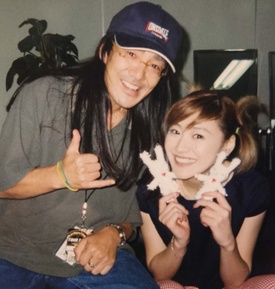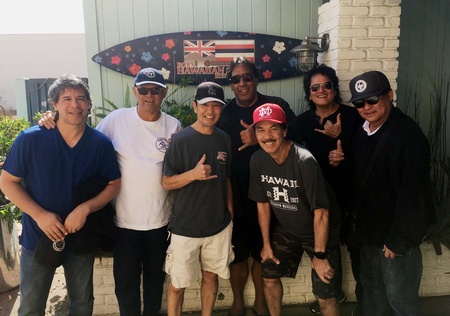Inside the base is the America I long for
Even though I've only been to Hawaii a few times as a tourist, there's a restaurant in Gardena, a suburb of Los Angeles, that brings back memories. The restaurant's name is Bob's Hawaiian Style Restaurant. As the name suggests, it serves Bob's Hawaiian cuisine. The current owner is Sato Kimiaki (hereafter Kimi), who took over from the previous owner, Bob. Even under Kimi's leadership, a new generation of Japanese, the restaurant continues to attract the support of regular customers from Hawaii. What is the secret behind this, and what kind of life has Kimi lived?
I had met Kimi once before at the bar, through a friend who was a regular customer. At that time, I learned about his turbulent past, including his previous work in the music industry, his role as a right-hand man to Tetsuya Komuro, who was based in Los Angeles for a time, and his subsequent involvement in fraud and the loss of two homes. Wanting to know more about his background, I met him at Bob's just before closing time to talk to him.
Born in Minato Ward, Tokyo in 1958. The US military base in Chofu was next to Komae City, where he lived during his upper elementary school years. "At that time, they were showing TV shows like 'Flipper' and 'The Partridge Family,' right? Just like on TV, on the other side of the fence of the base, there were houses with grassy yards, and I was envious and sneaked in a few times. Even though I couldn't speak English, I talked to girls (laughs)." After dropping out of high school in Japan after six months, he decided to go to high school in the US.
"My grandfather, who was the owner of a small business, supported me financially. My parents were very supportive of my going to America because I was a troublemaker. I don't think they took it seriously though, because they thought it was impossible. So when I was 16, I went to a boarding school in Vermont to study English, and then went to New York and worked part-time at a ramen shop in Time Square." However, since it was rare for minors to study abroad at the time, it was difficult to find a way to go. After that, I crossed the continent from New York to San Diego in a Datsun (Bluebird) with three friends from the English school. "When I came to California, I found that the climate was mild and it was closer to Japan than the East Coast, so I decided that this was the place for me, and I finally found a private high school that would issue me a visa and enrolled. I was in the same math class as Charles Bronson's son, and I was surprised that my history teacher was Peter Torkson of the Monkees."
From the entertainment industry to the food and beverage industry, and then to Tetsuya Komuro's right-hand man
At the age of 19, he graduated from high school in the US and entered university, but returned to Japan for a time. He then joined an entertainment agency through an introduction from someone he met in the US. After joining Masahiro Kuwana's agency, he worked at Tatsuro Yamashita's agency until he was 25. However, just when he was fed up with the human relationships, he learned that a sushi chef from the restaurant where he had worked part-time during high school was running several successful Japanese restaurants in Hollywood. "I decided to aim to be like Rocky Aoki, so I relied on this Japanese acquaintance and returned to the US. I started out as a dishwasher, then worked in the kitchen, sushi, and as a manager."
In 1988, he started managing a Japanese restaurant in Laguna Beach. However, it never got going and he sold it after a year and a half. By that time, he was married and had a child. His next job was as a recording coordinator. His job was to arrange hotels, studios, famous musicians and engineers to perform for musicians from Japan, and to complete the recording smoothly. "I had connections with people I knew from my time in the Japanese entertainment industry, so although it was tough, I started to get work little by little." It was a fun job that made him realize he could do creative work with musicians who were particular about sound, such as B'z, TUBE, HITOMI, TRF, George Yanagi, and Tetsuro Oda. He also started managing Japanese musicians who were aiming to enter the US (such as the band "CASINO DRIVE" by Takehiko Kogure, former member of Red Warriors, and Rei Atsumi, former member of BOW WOW). Furthermore, in 1996, when he met Tetsuya Komuro by chance, he was asked to be his personal manager when Komuro made his debut in the US, and he managed the executives of several companies he owned in the US, as well as the recording studio in Hawaii, and the real estate, villa and studio in Bali. His role ended in 2002 when Komuro returned to Japan.
Later, he was deceived by an American who became his new business partner, and lost most of his assets. "Maybe Japanese people are more likely to trust people they meet. But if you're doing business, you can't do it without trusting the other person, right?" It was during the trial that he started frequenting Bob's. He was also the booking agent for the Hawaiian band Kalapana, whom he had met while working as a sushi chef, and met Bob when he came to the restaurant to put up posters for their live show. He also liked Hawaiian food, so he started coming every day, and through that connection, he ended up taking over the restaurant from him."
An important place for Hawaiians
It has been 12 years since Kimi became the owner of Bob's. Initially, the restaurant was located in a less trafficked area of Gardena, but it later moved to its current location. This area is in what could be called the center of Gardena, with banks, hotels, and shops concentrated there. Kimi, who has a background in restaurant management, readily agreed to buy the restaurant, saying, "Since I love Hawaii, I think I can do it," but he recalls that things did not go smoothly.
"The Hawaiian community is very close-knit and doesn't accept outsiders very easily. At first, it felt like the regulars were watching me, wondering what I, a Japanese person, was trying to do. Eventually, they started giving me advice, which I readily accepted. Also, just like in Japan, we call older men "Uncle" and women "Auntie," and we adopted customs like greeting each other by kissing on the cheek. We continue to use Bob's recipes for the menu, but we added one thing, cold Chinese noodles, using my own recipe." And it's not just the food. There's a relaxing Hawaiian atmosphere there, with live Hawaiian music and interior design that evokes the atmosphere of Hawaii.
So, what are Kimi's thoughts about the future? "Firstly, I want to tour North America in a camper trailer. I could also become a tattoo artist. I trained in Japan and have some skills. Where should I live? There are still many countries I haven't been to, and I love Southeast Asia, especially Bali, so I might move there." It's a typical answer from Kimi, who has never been tied down to anything and has always been involved in whatever he comes across and finds attractive at the time.
Finally, we asked him when he feels truly Japanese, now that he has lived in America for a total of nearly 40 years: "For example, at the recent FIFA World Cup. The Japanese team played against other strong countries and put on a great game. When I felt the energy that was transmitted from that game. Also, when I'm teaching karate to children."
Even during the interview, regular customers coming in and out of the store would greet Kimi-san with words and hugs. Their gratitude to Kimi-san for protecting their precious place in the store was clear.
URL: Bob's Hawaiian Style Restaurant
© 2018 Keiko Fukuda








